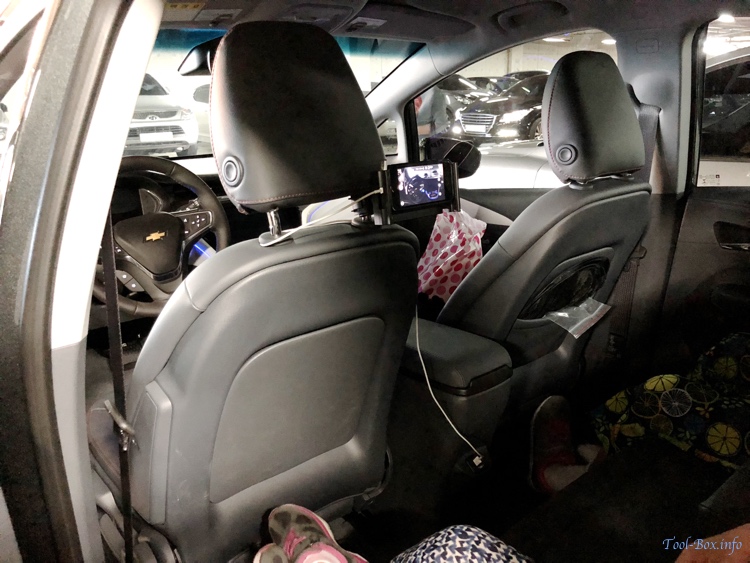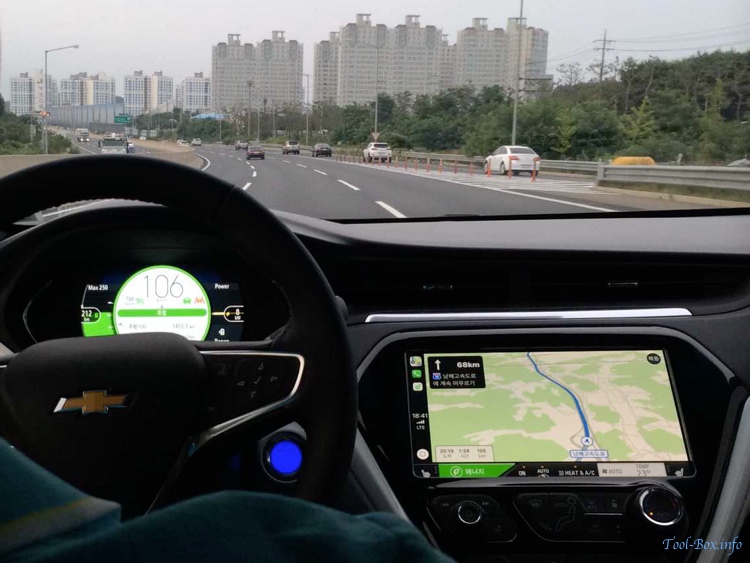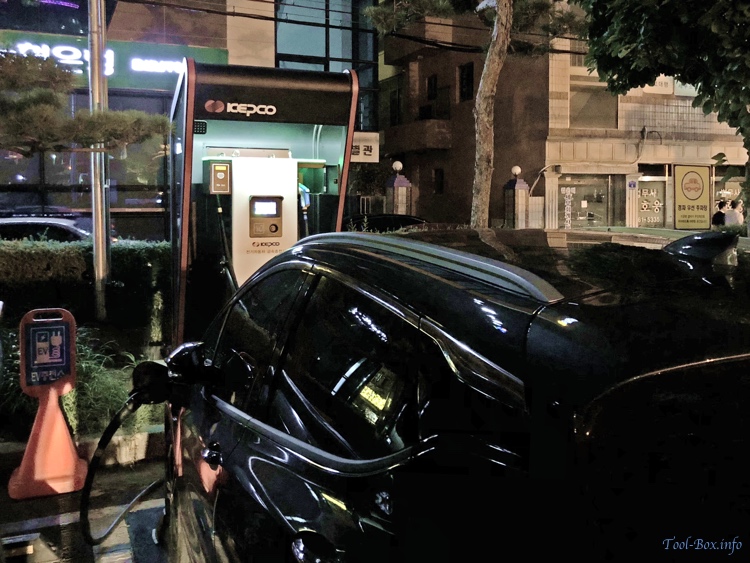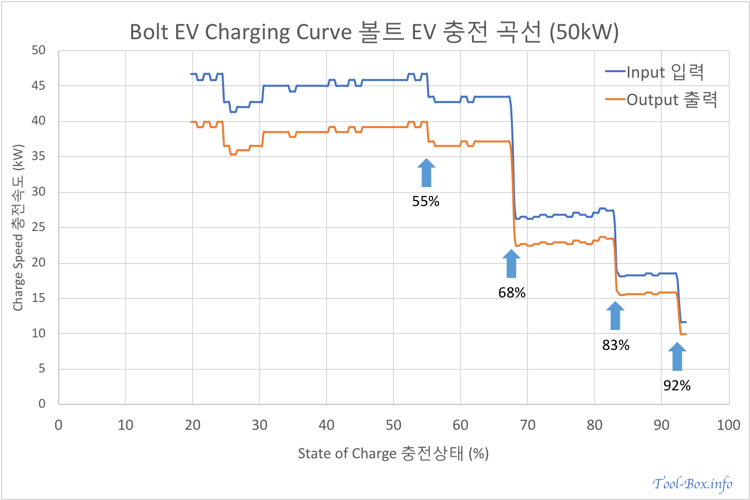On the road with Bolt EV, part 1
Posted by Wesley on
iPhone 5S set up for time lapse recording on the Bolt EV driver seat's headrest
It’s been more than a month since I started driving Bolt EV. The lack of any engine noise, as well as the responsive acceleration and regenerative breaking continue to impress even now. I felt that the car definitely belonged to the 21st century and was glad that this was the first car I bought. Driving experience aside, many still wonder and ask if the car is truly good enough for a long drive and whether the charging speed was any good. This is where showing the experience would be better than explaining.
Here is the video of my recent cross-country round trip with Bolt EV in time lapse mode using the setup you see in the photo above. It should be noted that the Korean Peninsula is only about 300km wide and the South Korean part is about 400km long. Therefore the “cross-country” isn’t on a such grand scale here. Still, the range of Bolt EV (383km) implies that it could go almost anywhere in the country with a single full charge and this is important for many potential buyers in Korea.
On the video, Bolt EV took on the task of taking my family on a routine trip to my parents’ home at the opposite coast. This trip from Naju to Ulsan covered a distance of 302.8km, of which more than three quarters were on the expressway. The day was warm and humid (more than 25C on average, with a bit of rain) and so the air conditioning was running, yet the car nevertheless passed with flying colours with plenty of margins to spare. We started out with 91% charge, and still had 18% left after reaching the destination. Let's see this in more detail.

Driving on the expressway with the Bolt EV's cruise control engaged and the Apple Maps navigating
For the path, I let the Apple Maps guide me throughout the trip. As Bolt EV supports Apple CarPlay, Apple Maps on my iPhone X was shown on the car's infotainment screen as a full-fledged navigation. For the Korean region, it needs work on the POI data, but the road and address data were relatively up to date. So it was possible to make it work fine in most situations, including this particular trip. Official 3rd party navigation app support is coming with iOS 12, but until then I can live with this arrangement without resorting to jailbreaking.
For the expressway driving, I made use of the cruise control and the Lane-Keeping Assist System (LKAS). The car's speedometer reports about 5% faster speed, so I set the cruising speed to 106km/h (it works in 2km/h increments) for the actual speed of about 101km/h as verified by the car's GPS-equipped dashcam. Occasionally, I let go of the steering wheel to see if the LKAS works as intended, and it did its job most of the time, including the curves, as seen in the photo. However, the car does not slow down with the traffic, but only give collision warning (via Forward Collision Warning System, or FCWS), so the usefulness was limited to sparse traffic conditions.
| Checkpoint / Type | Distance (km) | Elapsed (H:M:S) | Speed (km/h) | Est. Power (kWh) | Economy (km/kWh) |
|---|---|---|---|---|---|
| By Checkpoint | |||||
| Depart from Naju | 0.0 | 00:00:00 | - | - | - |
| Hwasun | 14.8 | 00:18:55 | 46.9 | 3.08 | 4.8 |
| Suncheon | 35.4 | 00:33:55 | 62.6 | 6.44 | 5.5 |
| Honam Expressway | 9.0 | 00:09:40 | 55.9 | -1.40 | -6.4 |
| Namhae Expressway | 22.1 | 00:13:24 | 99.0 | 4,90 | 4.5 |
| Gwangyang | 7.3 | 00:04:19 | 101.5 | 0.98 | 7.4 |
| Hadong | 23.9 | 00:14:18 | 100.3 | 3.51 | 6.8 |
| Sacheon | 16.8 | 00:10:14 | 98.5 | 3.22 | 5.2 |
| Jinju | 17.8 | 00:10:49 | 98.7 | 2.38 | 7.5 |
| Haman | 27.1 | 00:16:20 | 99.6 | 4.34 | 6.2 |
| Changwon | 27.8 | 00:18:49 | 88.6 | 5.04 | 5.5 |
| Gimhae | 7.3 | 00:09:48 | 81.4 | 1.96 | 6.8 |
| Busan Outer Belt Exp. | 1.8 | 00:01:04 | 101.3 | 0.28 | 6.4 |
| Busan | 29.2 | 00:17:29 | 100.2 | 3.22 | 9.1 |
| Donghae Expressway | 21.4 | 00:14:03 | 91.4 | 1.96 | 10.9 |
| Ulsan | 10.9 | 00:06:32 | 100.1 | 1.96 | 5.6 |
| Exit Expressway | 12.0 | 00:07:33 | 95.4 | 0.42 | 28.6 |
| Arrival in Ulsan | 12.2 | 00:21:59 | 33.3 | 0.42 | 29.0 |
| By Road Type | |||||
| Expressway | 231.4 | 02:24:42 | 96.0 | 34.2 | 6.8 |
| Regular Road | 71.4 | 01:24:29 | 50.7 | 8.5 | 8.4 |
| Total | |||||
| Naju-Ulsan | 302.8 | 03:49:11 | 79.3 | 42.7 | 7.1 |
By making note of when the car passed through the city/county limits and the expressway entrances/exits, I was able to assess the car's average speed from the distance and the elapsed time for each interval. Also, by using the car's drivable range on the left of the speedometer as a rough estimate of State-of-Charge, I was also able to derive the fuel economy as well.
Due to the topography, it is apparent that some intervals show better fuel economy than others. In the extreme cases, the drivable range climbed back up, resulting in a negative number. But if you grouped them together into two categories, expressway and the regular road, you can see that the former is lower (6.8 vs. 8.4) due to the high speed (average of 96km/h) having an adverse affect on the energy consumption. Still, it fared a lot better than the official numbers (5.7 and 6.7*). For the entire duration of the travel, Bolt EV consumed 42.7kWh for the 302.8km, resulting in the combined fuel economy of 7.09km/kWh. In other words, I can drive about 430km under the same conditions.
*[Approved values for drivable range and fuel economy in Korea are 349km & 5.1km/kWh for expressway and 411km & 6.0km/kWh for city, with the combined values of 383km & 5.5km/kWh. The fuel economy calculation takes the charging loss into account, so the numbers derived purely from the drivable range are 5.7, 6.7, and 6.3, respectively.]

Charging the Bolt EV at a KEPCO charging station in Nam District Office, Ulsan
After the arrival, the car was plugged into a 50kW charging station operated by KEPCO. The charging took 99 minutes, and the battery was charged 76% (from 18% to 94%), or 46.3kWh. The charger sent 54.02kWh, so the efficiency was 85.7%. I paid KRW 6,572 (US$5.87) after the 30% Shinhan EV credit card discount was applied.
Most of the so-called quick chargers in Korea are rated for 50kW output and supports three standards (CCS [DC Combo], CHAdeMO, and IEC 62196 Type 2 [3-Phase AC]) like the one you see here. CCS, the one used by Bolt EV, is the standard chosen by the Korean government, but the connectors for the other two are still installed on the new chargers for the near future for compatibility purposes. Since the one I used here was typical of what an EV owner would come across for a quick charger in Korea, I decided analyze the charging progress and the graph below is the result.

The observed charging curve for the Bolt EV at a 50kW charger
The charging curve is similar to what has been reported by other Bolt EV owners. It is charged at the maximum rate of about 45kW (0.94 min./%) up to 55% charge. Then it drops slightly to about 43kW (0.99 min./%). When the charge level is at 68%, the speed drops significantly, to about 27kW (1.6 min./%), then it is maintained until 83%. Considering that the "quick charging" is considered to occur up to 80% charge, Bolt EV's charging pattern is being conservative by throttling the speed about 12%-point early. The "slow charging" phase is still faster than a typical 7kW slow charger prevalent in Korea, by pushing in about 18kW (2.3 min./%) up to 92% and 12kW (3.6 min./%) after that.
I should note that my Bolt EV had the "Hybrid Powertrain Control Module 2 Reprogramming (Notice #N172127153)" applied. It appears that this software update did not largely alter the charging pattern. However, there's the mysterious speed dip between 25% and 30% is something others haven't experienced. I will check in the future charging observations to see if it was a one-time quirk or not.
To summarize, my Bolt EV was able to make a long-distance trip at normal speeds with a better-than-official fuel efficiency, so there was no need to stop and waste time for recharging along the way. In other words, the total travel time would be more or less the same as a conventional car so long as you plan properly and make proper use of the charging infrastructure before and after the trip. As for the fuel costs, it was less than 1/7 what I would have paid for a gasoline car (around US$43) to cover the same distance. If you make a lot of long distance trips, the car would pay for itself on fuel costs alone in a few years. All in all, Bolt EV turned out to be a fine choice for my needs.